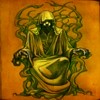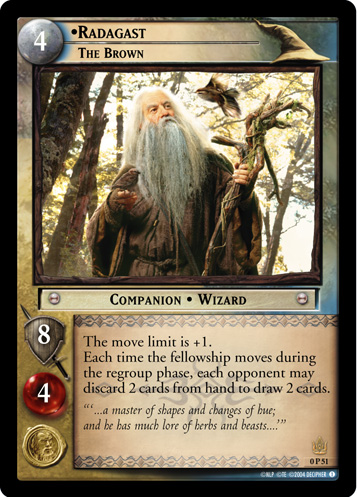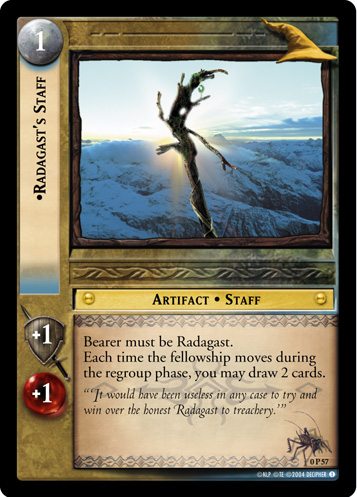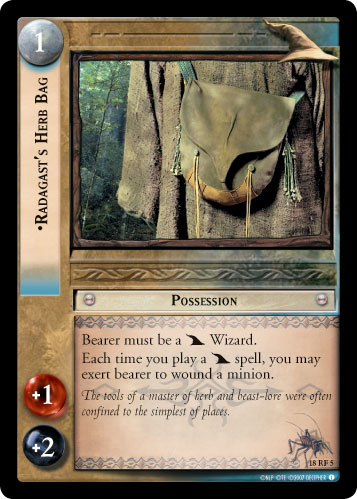The only record of Radagast being the 'cousin of Gandalf' is found in
The Hobbit:
'my good cousin Radagast who lives near the Southern borders of Mirkwood'
As with some other lore from
The Hobbit, it should NOT be taken literally (i.e. as a fact), unless confirmed in later lore. Tolkien's later writings clearly shows, that Radagast is NOT a cousin of Gandalf.
Early in the process of writing The Lord of the Rings, it is clear that Tolkien envisaged some role for Radagast in the tale. He eventually decided that he would use Radagast as the means of getting Gandalf to Isengard.
Initially Gandalf describes Radagast as his 'cousin', as he did in The Hobbit, but in a subsequent draft he becomes his 'kinsman'. In the final version Gandalf merely says that Radagast is 'one of my order'.
Tolkien's lore on the Istari did evolve later, in relation to
The Lord of the Rings and especially in writings later than the publishing of the trilogy. These later writings on the origin of the Istari clearly shows, that even Radagast was NOT just some 'Wizard', but a mighty power in his own right:
Of major interest is a brief and very hasty sketch of a narrative, telling of a council of the Valar, summoned it seems by Manwë ("and maybe he called upon Eru for counsel?"), at which it was resolved to send out three emissaries to Middle-earth. "Who would go? For they must be mighty, peers of Sauron, but must forgo might, and clothe themselves in flesh so as to treat on equality and win the trust of Elves and Men. But this would imperil them, dimming their wisdom and knowledge, and confusing them with fears, cares, and weariness coming from the flesh."
But two only came forward: Curumo, who was chosen by Aulë, and Alatar, who was sent by Oromë. Then Manwë asked, where was Olórin? And Olórin, who was clad in grey, and having just entered from a journey had seated himself at the edge of the council, asked what Manwë would have of him. Manwë replied that he wished Olórin to go as the third messenger to Middle-earth (and it is remarked in parentheses that "Olórin was a lover of the Eldar that remained," apparently to explain Manwë's choice).
But Olórin declared that he was too weak for such a task, and that he feared Sauron. Then Manwë said that that was all the more reason why he should go, and that he commanded Olórin (illegible words follow that seems to contain word "third"). But at that Varda looked up and said: "Not as the third;" and Curumo remembered it.
The note ends with the statement that Curumo [Saruman] took Aiwendil [Radagast] because Yavanna
begged him, and that Alatar took Pallando as a friend.
On another page of jottings clearly belonging to the same period it is said that "Curumo was obliged to take Aiwendil to please Yavanna wife of Aulë." There are here also some rough tables relating the names of the Istari to the names of the Valar: Olórin to Manwë and Varda, Curumo to Aulë, Aiwendil to Yavanna, Alatar to Oromë, and Pallando also to Oromë (but this replaces Pallando to Mandos and Nienna).
The meaning of these relations between Istari and Valar is clearly, in the light of their brief narrative just cited, that each Istar was chosen by each Vala for his innate characteristics – perhaps even that they were members of the "people" of that Vala, in the same sense as is said of Sauron in the Valaquenta (The Silmarillion p.32) that "in the beginning he was of the Maiar of Aulë, and he remained mighty in the lore of that people." It is thus very notable that Curumo (Saruman) was chosen by Aulë.
There is no hint of an explanation of why Yavanna's evident desire that the Istari should include in their number one with particular love of the things of her making could only be achieved by imposing Radagast's company on Saruman; while the suggestion in the essay on the Istari that in becoming enamoured of the wild creatures of Middle-earth Radagast neglected the purpose for which he was sent if perhaps not perfectly in accord with the idea of his being specially chosen by Yavanna. Moreover both in the essay on the Istari and in Of the Rings of Power Saruman came first and he came alone. On the other hand it is possible to see a hint of the story of Radagast's unwelcome company in Saruman's extreme scorn for him, as related by Gandalf to the Council of Elrond: "Radagast the Brown !' laughed Saruman, and he no longer concealed his scorn. 'Radagast the Birdtamer! Radagast the Simple! Radagast the Fool! Yet he had just the wit to play the part that I set him.'"
Other relevant information on Radagast and Rhosgobel:
... of the Five Wizards, Radagast was said to have been the fourth to appear in Middle-earth. Like all his Order, he carried a rod and had a distinctive colour (in Radagast's case this was Brown). In his earlier life in Valinor he had been a friend to beasts and birds (his original name was Aiwendil, 'bird-friend') and the living things of Middle-earth became his special province. He also had great knowledge of plants and herbs, and apparently possessed the ability to create illusions.
Like the others of his Order, Radagast had been charged with aiding Elves and Men in their coming struggle against the Shadow. Once in Middle-earth, Radagast came to prefer the company of animals and birds to that of the people he was sent to aid, and he ultimately achieved very little. He settled at Rhosgobel, near the southern borders of Mirkwood, in a location close enough to Dol Guldur to suggest that it may have played a part in the attack on that fortress by the White Council in III 2941. At some point later in history he abandoned this homestead.
Notes:
1) In Unfinished Tales of Númenor and Middle-earth, Christopher Tolkien indicates that his father intended to change this derivation and bring Radagast in line with the other wizard-names Gandalf and Saruman, by associating it with the old language of the Men of the Vales of Anduin. No alternative meaning is provided (indeed, Tolkien stated that the name was 'not now clearly interpretable'). One possible source (a somewhat unfounded conjecture) would be Old English rudugást, 'brown spirit' (rudu strictly means 'red' or 'red-brown').
2) Radagast's affinity for the creatures of the wild was not unique, and seems to have been shared by the other Wizards to some extent. Gandalf could certainly also communicate with birds and animals, and Saruman could apparently use birds as his spies.
3 According to Gandalf, Radagast was a 'master of shapes and changes of hue' (The Fellowship of the Ring II 2, The Council of Elrond). The meaning of this is open to question, but it seems to suggest that he was skilled at creating phantasms or illusions, or at disguising his appearance.
If Radagast could change his form, or trick the minds of others, that raises the curious possibility that he may have played other parts in the story of The Lord of the Rings than the ones we know. One obvious candidate would be the mysterious stranger encountered by Aragorn and his companions on the borders of Fangorn. This strange figure, never explicitly identified, is generally assumed (and reasonably so) to have been Saruman. On the other hand, his strange behaviour (wandering alone in dangerous territory, and doing no more harm than releasing the company's horses) hints that this just might have been Radagast in Saruman's shape.
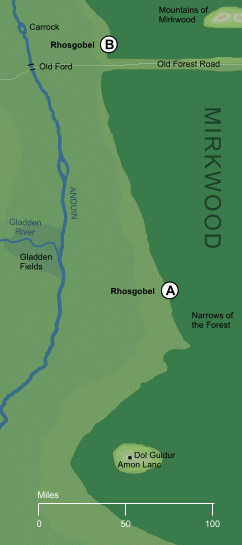
(A) is the best evidenced (in the older lore) and most consistent location for Rhosgobel,
though some (later) sources suggest that it was further north, at the position marked (B)
Notes:
1 We have no solid information to confirm when the Wizard Radagast settled at Rhosgobel, and hardly any basis for guessing when that might have been, except that it must have been after the arrival of his Order in Middle-earth in about III 1000.
Whenever Rhosgobel was founded, it seems that Radagast still dwelt there long into the Third Age. In The Hobbit (chapter 7), Gandalf speaks of 'my good cousin Radagast who lives near the Southern borders of Mirkwood', which strongly suggests that he was still at Rhosgobel in the year III 2941 when Bilbo's adventures took place. In fact, given its location close to Dol Guldur, it probably played an important part of the attack against Sauron that took place in that year.
At the Council of Elrond in III 3018, however, Gandalf announced that Radagast 'at one time dwelt at Rhosgobel' (The Fellowship of the Ring II 2). So, we must assume that the Brown Wizard left his home sometime between these two dates. The estimate of c. III 3000 given above is based on this reasoning, though clearly there is considerable margin for error here.
2 There is a certain amount of confusion over the exact location of Rhosgobel. The initial draft map for The Lord of the Rings, reproduced in volume 7 of The History of Middle-earth, shows it in the far south of the forest, precariously close to Dol Guldur. However, in the notes to The Istari in Unfinished Tales, Christopher Tolkien quotes the location as being 'in the forest borders between the Carrock and the Old Road', which would place it much farther to the north.
The latter location seems to fit the established dating rather better, allowing for Radagast to remain there safely long into the Third Age. However, the only remotely canonical statement comes from The Fellowship of the Ring II 3, where the scouts of Elrond 'had come down into Wilderland and over the Gladden Fields and so at length had reached the old home of Radagast at Rhosgobel.' This description can only reasonably apply to the southern location, near Sauron's stronghold at Dol Guldur.
The relations between these two variable accounts are unclear. The southern version appears to be the older, so perhaps Tolkien intended to revise Rhosgobel's location to place it in less direct danger from Sauron. If so, however, that change never made it into the text of The Lord of the Rings. We can place Rhosgobel, therefore, on the western fringe of the Narrows of the Forest, opposite the East Bight.
Edited by Námo, 28 December 2012 - 06:03 PM.




